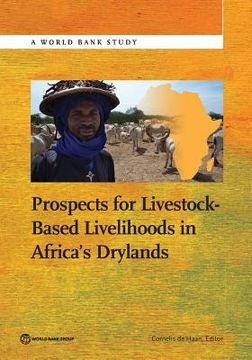Share
Prospects for Livestock-Based Livelihoods in Africa's Drylands
De Haan, Cornelis (Author)
·
World Bank Publications
· Paperback
Prospects for Livestock-Based Livelihoods in Africa's Drylands - de Haan, Cornelis
Choose the list to add your product or create one New List
✓ Product added successfully to the Wishlist.
Go to My Wishlists
Origin: U.S.A.
(Import costs included in the price)
It will be shipped from our warehouse between
Friday, July 19 and
Tuesday, July 30.
You will receive it anywhere in United Kingdom between 1 and 3 business days after shipment.
Synopsis "Prospects for Livestock-Based Livelihoods in Africa's Drylands"
Prospects for Livestock-Based Livelihoods in Africa s Drylands examines the challenges and opportunities facing the livestock sector and the people who depend on livestock in the dryland regions of Sub-Saharan Africa. It presents a novel way of thinking about pastoral development, grounded in a conceptual framework that focuses on the multiple shocks that drylands livestock keepers face and how those shocks can be addressed, drawing on a state-of-the-art literature review carried out by scientists of leading research institutes and development organizations, and integrating the results of an innovative approach to modeling development options for the drylands livestock sector. Looking to the future, the picture is mixed. On the positive side, demand for red meat is expected to strengthen in domestic and regional markets, suggesting that livestock keepers will have good market opportunities. On the negative side, a large majority of livestock keepers are classifi ed as poor, and the natural (feed) resource base is likely to be suffi cient to enable improved meat and milk production for the growing human population. Prospects for the livestock sector through 2030 vary by aridity zone. In arid and semi-arid zones, a reasonable goal for 2030 is to have land use, training, and microfi nance systems established that promote an appropriate balance between human and livestock carrying capacities, featuring mainly grassland/pastoral systems that reliably and sustainably satisfy the minimum income needs of herder households, produce at least a signifi cant part of the demand in local markets for animal source food, and provide environmental services for which livestock keepers receive compensation. The goal includes signifi cant employment generation outside the sector. In the higher rainfall zones of the semi-arid areas, and in the subhumid zones, a reasonable goal for 2030 is to have intensifi ed production systems established, featuring mainly mixed livestock/arable farming or agro-pastoral systems that are closely linked to nearby grassland/pastoral systems and that consistently generate marketable surpluses of differentiated red meat and livestock products that can compete not only in the expanding domestic market but also in selected regional markets."
- 0% (0)
- 0% (0)
- 0% (0)
- 0% (0)
- 0% (0)
All books in our catalog are Original.
The book is written in English.
The binding of this edition is Paperback.
✓ Producto agregado correctamente al carro, Ir a Pagar.

